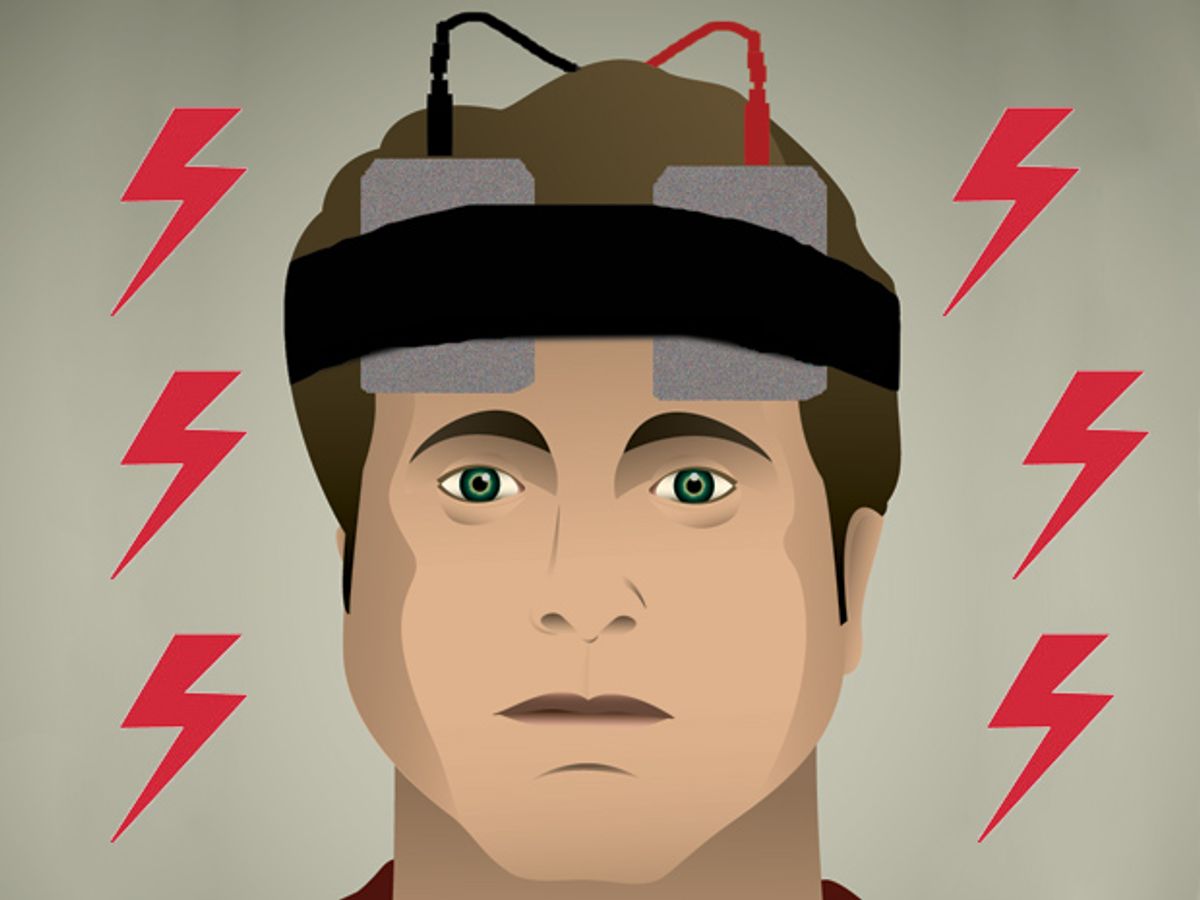The largest meta-analysis yet of the ability of one kind of electrical brain stimulation technology to alter how people think and feel has found no evidence that it has any effect on healthy adults.
Jared Horvath, a neuroscientist at the University of Melbourne, in Australia, looked at every study of transcranial direct current stimulation (tDCS) that reported an impact on cognitive and behavioral activities such as problem solving, learning, mental arithmetic, vision tasks, and memory games. He then excluded results that had not been replicated by other researchers, as well as any experiments lacking a “sham condition” control group—where participants were connected to the device but didn’t receive current. While many of the more than 200 individual studies that remained claimed to have found significant effects, those effects disappeared after Horvath’s number crunching. “When I pulled out the 20 studies looking at tDCS and working memory, for example, they all found something, but they all found something different,” says Horvath.
One study may have found an effect on accuracy, another on reaction time, and a third on response confidence. “But when I brought them together, they just canceled each other out, and I was left with nothing,” he says. It was a similar story for more than 100 other cognitive and behavioral outcomes. “It looks like the evidence says tDCS is not doing anything.”
This news may come as a shock to the thousands of DIY brain hackers who have been building and using tDCS devices in the hope of boosting their brainpower at the push of a button. Many of those biohackers constructed their own brain zappers from 9-volt batteries and simple circuits for as little as US $10. The impact of Horvath’s paper could be even more serious for companies hoping to sell designer tDCS machines, for much higher sums, to a mainstream audience as “cognitive enhancement devices.”
Felipe Fregni, director of the Laboratory of Neuromodulation at Harvard Medical School, shares some of Horvath’s caution but is adamant that the technology has been proved. “tDCS is not a magic…bullet, and the effects are very small,” he says. “But we’ve seen over and over in different studies that it helps you to learn new skills. It helps you to activate neural networks that were deactivated or never used before.”
“There’s probably someone out there that this really works for,” admits Horvath. “But if it only works for one person, one time, is that really an effect, or is it a placebo or some statistical anomaly you can’t repeat? And for all those outcomes that have been repeated, there are almost twice as many that haven’t been replicated. A huge body of the literature are one-offs.”
Horvath’s latest results, which were presented at the Australasian Society for Cognitive Science conference in December, follow hot on the heels of another meta-analysis he conducted. That one found that tDCS did not have any significant physiological effects on the brain.
The new findings do not surprise Jamie Tyler, a neuroscientist at Arizona State University and chief science officer of Thync, a start-up that raised $13 million to launch a smartphone-controlled tDCS device at the Consumer Electronics Show last week. “This meta-analysis is not shocking to me at all,” he says. “We tried to replicate some basic tDCS findings and did not find an effect on any of those cognitive parameters either.”
Tyler claims to have then gone back to the drawing board, using a new (and unpublished) approach to tDCS that generates reliable psychological responses. Thync’s device will be marketed as producing either energetic or stress-busting neurosignaling electrical waveforms that Tyler calls “vibes.” But even with his modified tDCS technology, Tyler says that his company has found no effects on cognition.
Not every neuroscientist is as quick to dismiss decades of tDCS research. “Individual differences can mask effects and even lead to opposite results,” says Roi Cohen Kadosh of the University of Oxford, in England. He recently published research showing that identical tDCS stimulation in people who were either nervous or confident about their mathematical abilities produced opposite behavioral and physiological effects. The anxious mathematicians improved their skills, while the skills of the confident ones deteriorated. Over a large enough population, he says, any such positive and negative effects would average out to nothing. “It is highly likely that the research groups are sampling their participants from a similar environment [usually undergraduate students] and therefore reducing the impact of individual differences,” says Kadosh.
In the past, meta-analyses of tDCS for medical problems such as depression and chronic pain have suggested that it may have beneficial effects in a clinical setting. Horvath admits that much more research needs to be done. “We want tDCS to work so bad that we’re forgetting the foundational stuff that we should be focusing on, systematic research just changing one variable at a time,” he says. “That’s going to kick our butt, because if you don’t have a solid foundation, sooner or later the whole thing crumbles.”
Mark Harris is an investigative science and technology reporter based in Seattle, with a particular interest in robotics, transportation, green technologies, and medical devices. He’s on Twitter at @meharris and email at mark(at)meharris(dot)com. Email or DM for Signal number for sensitive/encrypted messaging.



